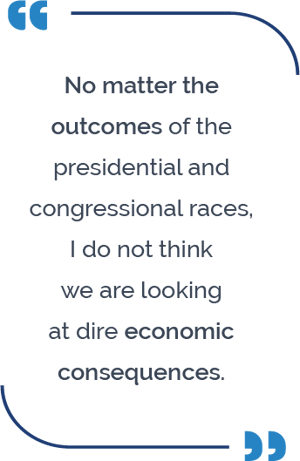We’ve gone without a lot of things in 2020. Surprises aren’t one of them. After ten months of twists and turns, most of us are ready for a nice long stretch of the mundane. But this has been a strange year, and neither the year nor, I fear, the strangeness is over.
US federal elections are 11 days away, and markets currently seem to anticipate a “blue wave.” But I think the US political landscape could still offer some surprises. The scenarios below, in my view, could make some waves of their own in capital markets.
Control of Congress
Control of the Senate is considered a big wild card. Pundits and markets seem fairly confident that Democrats will hold on to the House of Representatives in November, and former Vice President Biden is currently favored by most polls and prediction markets to win the White House. This would make the Senate key, and our confidence in forecasting the outcome is lower.
 To make things extra exciting, there are two Senate races in Georgia this year. One or both of these seats could be involved in a special run-off election on January 5 if no candidate were to get over 50% of the vote on November 3. Given how close control of the Senate is, Georgia could potentially determine party control of the Senate, which would affect how effectively the presidential winner can govern. Yes, Georgia is on my mind.
To make things extra exciting, there are two Senate races in Georgia this year. One or both of these seats could be involved in a special run-off election on January 5 if no candidate were to get over 50% of the vote on November 3. Given how close control of the Senate is, Georgia could potentially determine party control of the Senate, which would affect how effectively the presidential winner can govern. Yes, Georgia is on my mind.
Markets could react to the results for the Senate in either direction. If Republicans were to keep the Senate, they would potentially be able to block key Biden initiatives including tax hikes and spending plans on initiatives like combating climate change. I could see a market relief rally in this scenario. If the Democrats were to take the Senate—and accomplish a clean sweep of the House, the Senate, and the White House—they would potentially be able to pass an ambitious taxation and spending agenda. Biden’s proposed tax plans would be the largest peace-time tax hike in US history, and the spending agenda could be considered one of the most ambitious since Lyndon Johnson’s “Great Society” agenda in 1965. Markets follow the polls and appear to have started to price a potential Democrat clean sweep, but I am not sure the markets have fully digested the profound effects the agenda could have on certain industries. The complex dynamics of the pandemic and economic recovery have been affecting market pricing as well as political prospects.
For the House, I don’t expect markets to react if Democrats were to retain control. But if the Republicans were to take the House, markets could be in an uproar.
A December to remember
December could be a very interesting month. Two major variables—a continuing resolution for the federal budget and potential legal challenges to the election—could be in play at the end of this year. Here’s a look at each.
- Continuing resolution (CR): The CR currently funding the federal government expires December 11. At that point, Congress and President Trump will have to agree to a fresh CR to avert a federal government shutdown. But with the elections behind them, some members of Congress (especially those who may have lost reelection) could be less concerned about alienating voters with a shutdown. Party agendas could clash as Congress debates a new CR. If Congress should fail to reach an agreement by the December 11 deadline, the resulting federal shutdown would last until January 3, 2021, when the new Congress is set to meet.
Election results could factor in here. If Trump were defeated, I doubt he would pound the table for a new CR. If Trump were reelected and Republicans were to hold the Senate, Democrats might negotiate with Republicans to include a modest fiscal package in the December CR. If Biden were to win and Democrats were to take the Senate, Democrats might agree to a clean CR so that they could potentially pass a larger fiscal package in 2021.
- Electoral process & legal challenges: While we should know who has won the presidency by December 14 (when the Electoral College votes), intricacies of the process could complicate things. Given how close the election might be, a faithless elector could potentially decide the outcome. (In 2016, seven faithless electors voted for someone other than Donald Trump and Hillary Clinton for president.) Some states have laws impelling electors to vote as pledged, and if the pledges are violated, there could be court challenges. We could also see a final set of challenges to count all the votes and determine the outcome of the Electoral College in November and early December. If the Electoral College fails, or in the small chance of a tie, the new House of Representatives will decide the election in January.
 If there are lawsuits or controversies during the presidential election—and I think there will be—December 8 is the date by which those issues would likely need to be resolved. This is the “safe harbor” deadline (federal law requires states to determine their electors six days before the electors vote for president and vice president). The safe harbor date has been an important hard line in past presidential elections. In the landmark US Supreme Court case in 2000 of Bush v. Gore, the Court essentially ruled that there wasn’t enough time to complete a recount by the safe harbor deadline. (The 2000 case is also a reminder of the role that the Supreme Court could play in a contested election scenario and why the timing of Amy Coney Barrett’s Supreme Court confirmation is significant.)
If there are lawsuits or controversies during the presidential election—and I think there will be—December 8 is the date by which those issues would likely need to be resolved. This is the “safe harbor” deadline (federal law requires states to determine their electors six days before the electors vote for president and vice president). The safe harbor date has been an important hard line in past presidential elections. In the landmark US Supreme Court case in 2000 of Bush v. Gore, the Court essentially ruled that there wasn’t enough time to complete a recount by the safe harbor deadline. (The 2000 case is also a reminder of the role that the Supreme Court could play in a contested election scenario and why the timing of Amy Coney Barrett’s Supreme Court confirmation is significant.)
And remember, the presidential election isn’t the only one that could be contested. Every Senate race, state by state, could face legal challenges related to ballots, vote counts and deadlines.
Strange days indeed
These days, it seems anything could happen. I think it’s safe to say that we are heading into a volatile political period. We should be prepared for a tough November and perhaps a tough December also. No matter the outcomes of the presidential and congressional races, I do not think we are looking at dire economic consequences. There are ups and downs after elections, and I don’t expect this time to be any different. The final months of 2020 may be challenging, but they could bring some buying opportunities.
MALR026282
Investment recommendations may be inconsistent with these opinions. There is no assurance that developments will transpire as forecasted and actual results will be different. Information, including that obtained from outside sources, is believed to be correct, but Loomis Sayles cannot guarantee its accuracy. Market conditions are extremely fluid and change frequently.
This is not an offer of, or a solicitation of an offer for, any investment strategy or product. Any investment that has the possibility for profits also has the possibility of losses.
Market conditions are extremely fluid and change frequently.
This blog post is provided for informational purposes only and should not be construed as investment advice. Any opinions or forecasts contained herein reflect the
subjective judgments and assumptions of the authors only and do not necessarily reflect the views of Loomis, Sayles & Company, L.P. Information, including
that obtained from outside sources, is believed to be correct, but Loomis Sayles cannot guarantee its accuracy. This material cannot be copied, reproduced or
redistributed without authorization. This information is subject to change at any time without notice.




